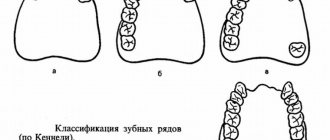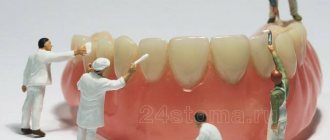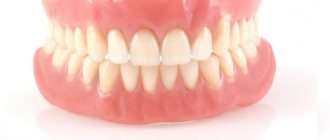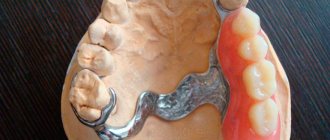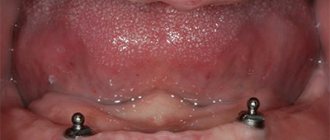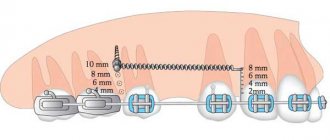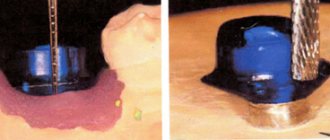A clasp denture is an ideal solution for restoring a number of teeth in the lower jaw, when the patient has retained several of his dental units, but it is not possible to install a full-fledged bridge on them for objective reasons. Also, this design is ideal if the patient does not want (or cannot) install implants, but wants to restore his smile and achieve optimal results for a reasonable budget. Yes, the clasp prosthesis for the lower jaw is a removable model, but it copes with the task perfectly, is a worthy alternative to outdated plate models, and the service life of such a solution is from 10 years.
What is a clasp prosthesis?
Clasp dental prosthetics is a widely used treatment method in orthopedic dentistry. Designed to restore teeth in both the lower and upper jaws. The name itself comes from the German “bugel”, which means “arc”, that is, bugel - literally “having an arc”. The design of clasp dentures includes a metal or plastic arch, artificial teeth that are attached to a base that imitates gums, and fixing elements in the form of hooks, clasps or crowns.
How much does a clasp prosthesis cost?
The price of lower jaw prosthetics using a clasp design depends on the following factors:
- base and frame material;
- the number of teeth that need to be restored with a prosthesis;
- material for dental crowns.
The average price of a clasp prosthesis is from 32,000 rubles. The price, as a rule, already includes payment for the prosthesis itself, treatment planning, installation of the system, and check-ups with the dentist.
Clasp dentures are an inexpensive and accessible way to restore a smile with a long service life (more than 10 years).
Stages of making a clasp prosthesis
Based on the principle of making the frame, the clasp prosthesis is divided into several types: soldered, solid-cast, milled, and based on laser sintering of nanoparticles of a special metal alloy powder. The last two methods are considered the most progressive and allow you to create a high-precision (up to 10 microns) and comfortable design.
Manufacturing takes place in 4 stages:
- first the dental technician creates a plaster model
- Based on the plaster model, a prototype of the prosthesis is cast and scanned
- using the scan, the frame of the clasp structure is modeled on a computer
- the prosthesis is ultimately sintered or milled.
The result exceeds all expectations - the prosthesis fits tightly to the gums and teeth, does not break and looks very aesthetically pleasing.
Advantages of treatment at ROOTT dentistry
ROOTT specialists have extensive experience in partial dentures, as they work every day with patients in need of dental reconstruction. The cost of clasp dentures depends on the complexity, materials, and type of fixing elements. ROOTT clinics in Moscow perform clasp prosthetics based on the condition of the patient’s teeth and gums. Dentists will select a method of dental prosthetics, taking into account the diagnostic results and the clinical picture. High-quality prosthetic structures are manufactured in our own dental laboratory using advanced computer technologies. The price for clasp dentures is formed on a turnkey basis.
Indications for clasp prosthetics
The main indication for clasp dentures is the inability to install dentures on implants and the presence of at least several supporting teeth to which it could be secured. Partial structures are most often used both to replace several teeth with terminal defects and to restore a single tooth.
Whereas the clasp upper and lower denture completely reproduces the entire dentition. In addition, there is a splinting clasp prosthesis, which is used as a structure that restores and supports teeth. The prosthesis splints teeth affected by periodontitis or periodontal disease from the inside, replaces missing parts of the dentition and prevents the occurrence of adentia and prolongs the performance of the affected teeth.
Contraindications include:
- oral diseases in the acute stage
- increased tooth wear
- diseases leading to bone loss
- low or missing abutment teeth
- deep bite
- chronic neurological and mental diseases
- short frenulum of the tongue
- shallow floor of the mouth
- allergy to metal or other materials used in the design
On the upper jaw
Dentures for the upper jaw are made from openwork casting using durable medical alloys
Clasp prosthetics of the upper row is performed in the absence of one or more teeth.
If there is no tooth, 4 implants are implanted. The prosthetic structure at the location of the artificial teeth is fixed to the jaw, and the arch itself is fixed to the palate.
Among all types of clasp products, attachments and splinting dentures are popular when restoring the upper jaw.
Clasps meet functional needs, but significantly lose in aesthetics. Therefore, they are rarely used for the top row.
Dentures for the upper jaw are made from openwork casting using durable medical alloys.
The connecting element (palatal membrane) does not cover the entire surface of the palate, which makes the process of adaptation quick and comfortable. The peculiarity of upper jaw prosthetics is a more complex technique for performing the work.
Clasp prosthetics of the lower jaw are easier. The design of the prosthesis looks simpler; it lacks the palatal part. The entire load is borne by the supporting teeth, to which the product is fixed. All types of clasp dentures are suitable for restoring the lower dentition.
Types of clasp dentures
Clasp dentures are also divided according to the method of their attachment to the supporting teeth. Unlike completely removable structures, which are fixed by suction to the gum or using special adhesives, fixation and installation of clasp dentures occurs using several types of fastening.
On clasps
Clasp dentures with clasps consist of metal hooks that clasp the abutment tooth in the neck area. The clasp clasp prosthesis is attached without grinding down the enamel, provided that the supporting teeth are not destroyed or affected by severe caries. However, this type is not aesthetic enough - the hooks are noticeable when you smile.
On locks or attachments
A locking clasp prosthesis consists of two parts, one of which is attached to the ground abutment teeth, and the second with the help of locks to the prosthesis itself. Unlike other types, a clasp denture with attachments is more immobile, so the load is distributed evenly on the supporting teeth and the alveolar mucosa.
Clasp prosthesis on telescopic crowns
When installing a clasp prosthesis on telescopic crowns, first fixed metal crowns are placed on the supporting teeth, and then ceramic crowns are placed in the prosthesis.
Types of locks, lock fastenings
Clasps for the upper jaw are available in several versions, which differ mainly in shape:
- ring;
- horseshoe-shaped;
- in the form of a transverse strip.
Designs with clasps are considered the most common.
Varieties of this group differ in retaining elements:
- Roach's clasps look like T-shaped extensions that extend from the frame arc and are placed in recesses. The products provide good fixation, but the process of placing them is quite complicated.
- Bonneville clasps represent a group of reversible structures. Crossing the occlusal surface transversely, they are placed on the vestibular and oral parts of the incisor (molar). It is appropriate to use in cases where there is a gap between the teeth. The clasp fills it completely, which eliminates the accumulation of food residues.
- Reichelman clasps are distinguished by their transverse design and the presence of an occlusal lining in the form of a special partition.
- Continuous clasp - the design is made up of several links fastened together. The product is placed orally or vestibularly. The peculiarity lies in the tight fit of each link to natural teeth, which ensures strong fixation.
- Embrasure clasps are essentially a type of Bonneville clasps, but the two elements included in the design are directed in opposite directions. The products perform a stabilizing function, so they are often used for splinting.
Continuous clasp
Embrasure clasp
Bonneville clasp
Roach's clasp
Reichelman clasp
Nylon clasp quadrotti prosthesis
A product of the Italian company Quattro Ti, the quadrotti clasp prosthesis is very similar to a removable nylon prosthesis, with the only difference being that during its manufacture, nylon is mixed with hypoallergenic plastic. The resulting material has a number of advantages: it is more durable than nylon, and artificial teeth do not show through it. According to the manufacturers, this type of metal-free clasp prosthesis does not deform over time, does not cause discomfort when worn, and looks much more aesthetically pleasing than other prostheses. A soft prosthesis is attached to the teeth using plastic clasps, or saddles, covered on top with the same material as the base of the prosthesis. Saddles can be either pink or white, making them unnoticeable on the teeth. As for the disadvantages of the prosthesis, firstly, Quattro Ti is not strong enough, since no matter how strong the plastic is, it cannot be compared with metal. Secondly, a clasp prosthesis with nylon saddles requires special care using special means, which requires additional costs and cannot be repaired.
By what parameters is the variety selected?
To solve problems with loose teeth, a splinting prosthesis is more suitable
Each type has a number of advantages, but the cast design is considered the most reliable, so when choosing the type of fastening, preference should be given to a solid product.
To solve problems with loose teeth, a splinting denture is more suitable.
Its design is created in such a way that natural teeth are fixed in their natural position.
With prolonged exposure of the units to the units, the neck of the tooth in the dentin is strengthened. The same products are recommended in case of malocclusion. The stabilizing properties of the arch make it possible to correct the defect during prolonged wear.
A locking design is chosen for partial loss of teeth, when several units are missing in a row. It is appropriate to use a clasp when there are supporting teeth, which will allow you to redistribute the load on them during chewing.
Caring for clasp dentures
Getting used to the clasp denture may take a couple of days. At first it will be somewhat uncomfortable for you to talk, so you will have to get rid of speech defects with the help of special exercises. Eating will also cause some difficulties. At first, to minimize pain, it is best to divide food into small portions and exclude very hard foods and sticky sweets from the diet. In order to quickly get used to the prosthesis, do not take it off at night.
Twice a day (morning, evening) it is necessary to remove the clasp prosthesis and clean it of plaque using the means recommended by the doctor, and also rinse it in a special antibacterial solution.
The clasp denture should be stored in a container, but not in water. Some types of structures, for example, soft quadrotti dentures, require special care, otherwise they fade and look unsightly on the teeth.
Prosthetics for complete absence of teeth and for one tooth
In case of complete absence of teeth, clasp dentures are installed in one case - when supported by implants. This is a more advanced prosthetics principle from a functional point of view. It allows you to avoid resorption of the jaw bone tissue, evenly distributing the load on the bone.
Clasp prosthetics for one tooth before the advent of thermopolymer products were considered illogical, since they required grinding down adjacent and often completely healthy crowns. Metal-based dentures made it possible to replace a lost tooth only as part of complex structures - with lateral end defects and included defects of the anterior teeth.
Thanks to Quadrotti technology, there is currently no need to prepare adjacent healthy teeth for a prosthesis. And a single included defect in the dentition is successfully replaced with an elastic thermopolymer “butterfly”.
Advantages and disadvantages
For comparison, let’s take the clasp’s “classmates” - fixed bridges and removable plate prostheses. Clasp orthopedic structures, of course, are superior to plate ones in strength, but, like bridges, they are a temporary way to restore the dentition. Despite all the efforts of manufacturers, the clasp is not able to stop the loss of bone tissue, the inevitable decrease of which soon leads to changes in facial features and disturbances in the functioning of the dental system and internal organs. The obvious disadvantages of a removable clasp also include an aesthetic defect when installing a clasp prosthesis, when metal hooks attached to the teeth are visible, and a slow adaptation time to the design. In addition, any denture puts pressure on the gums and causes discomfort when chewing and hypoxia - a condition in which the gums do not have enough nutrition, which causes bone tissue to atrophy even faster. As for the service life of clasp dentures, compared to dental implants, it is quite short and is no more than 10 years. Subject to proper care and timely correction once a year.
Nylon or acrylic: which is better?
Nylon prostheses are called “flexible” due to their elasticity. They are more convenient, and also less noticeable, than their predecessor counterparts - removable structures made of acrylic. The products are more aesthetically pleasing, but have a higher cost. A small list of contraindications for prosthetics. They do not cause allergic reactions. These elastic designs are created with a soft nylon base that is almost invisible in the mouth. The products are very comfortable to wear.
Undeniable advantages
nylon products:
- hypoallergenic - can be used for allergies;
- ease of care of the medical system;
- durability - have a long service life;
- durable and elastic, easy to use - able to withstand significant mechanical loads;
- have reliable fastening;
- do not require grinding of adjacent teeth or other painful procedures during installation;
- gel agents are not required for their fixation;
- can be worn constantly;
- does not accumulate foreign odors;
- microbiological inertness - the development of various pathogenic bacteria on the surface of the prosthesis is not supported;
- are easy to polish, so they fit tightly to the gums;
- diction is not violated;
- can be used by people suffering from heart disease and diabetes;
- It is possible to select any crown material for the manufacture of the product - the technology is available to people with different incomes.
There are also disadvantages
: fragility and softness of the manufacturing material - does not always withstand the load created during chewing. Over time, the structure “sags,” which can lead to gum injury. When wearing such structures, you should definitely monitor your oral cavity and visit the dentist with the frequency recommended when purchasing dentures.
Acrylic dentures have become widespread and inevitably enjoy considerable popularity. They are noticeably inferior in aesthetic characteristics to conventional ceramics or options made from metal ceramics. The weight of the structure is light, it does not require special care, and most importantly, it is inexpensive.
In a significant number of cases, older people are given acrylic dentures, which have an optimal quality-to-price ratio. They can be placed with partial or even complete edentia. And they are also recommended in cases where the patient has a significant gap in a row of teeth.
Advantages of acrylic products:
- almost absolute absence of contraindications;
- the product is suitable for both temporary and permanent wear;
- pleasant and easy to use
- has many shades, and therefore the color of artificial teeth will not differ from real ones;
- fastening using hooks allows you to avoid grinding down adjacent teeth;
- suitable for people of different age groups;
- have a reasonable price.
There are also disadvantages: the difference between an acrylic prosthesis and a nylon one is that it emits acrylic methacrylate, which can be negatively tolerated by the body; In the process of wearing dentures, the teeth adjacent to them are subject to abrasion, and the development of caries can result from this. They are quite fragile, despite this they can be used for about 8 years. It will take some time to get used to them.
How much does partial denture cost?
The average cost of clasp dentures in Moscow consists of the cost of the material, the work of the dental technician and the method of attachment to the supporting teeth. So, despite their popularity, the cost of nylon quadrotti dentures for one jaw is approximately the same as the price of clasp dentures - from 45,000 rubles and more. Clasp dentures with locks are somewhat more expensive - from 35,000 to 80,000 rubles. The most expensive of removable structures are considered to be dentures with telescopic crowns - their price ranges from 100,000 rubles to 200,000 rubles and more. As for clasp dentures on implants, their cost starts from 90,000 to 200,000 rubles and more, depending on the number of implants installed. If you decide to have a clasp prosthesis installed, then choose trusted clinics here.
High-quality clasp prosthetics is a worthy alternative to implantation, and in times of economic depression, clasp prosthetics is the most optimal option for restoring missing teeth.
Making clasp
The stages of manufacturing a clasp prosthesis include a clinical and laboratory stage. Clinical includes:
- Comprehensive diagnostics, development of a detailed therapeutic plan, identification of supporting teeth, their preparation.
- Taking impressions of the patient's dental system. To make a clasp denture, two impressions are required from each jaw.
- After manufacturing the system, try it on and make adjustments if necessary.
- Fixing the denture in the mouth.
Laboratory stage:
- Creation of a plaster model using casts taken.
- Casting a prototype system based on it, scanning it.
- Computer modeling of the arch of an orthopedic system.
- Sintering, casting or milling of the frame, its polishing, grinding.
- Base modeling, selection, fixation of artificial crowns.
- Trying on a prosthesis for a patient.
- Final assembly, processing of the orthopedic structure.
Modern technologies eliminate metal shrinkage or base deformation during operation.
Alekperov Roman Borisovich Dentist-orthopedist, doctor of the highest category
If there are no 4 chewing teeth in a row on the lower jaw, which prosthesis is better - a bridge or a clasp?
If 4 teeth are missing in a row, a defect of a very large length is formed, so the bridge simply cannot withstand such a load and will fail. In the area of chewing teeth, the load on the axles reaches 600 kg, so in this situation, there are two treatment options - clasp prosthetics or implantation. To get a complete clinical picture, you need to take pictures and come to us for a consultation.
Alekperov Roman Borisovich Dentist-orthopedist, doctor of the highest category
Please tell me how many supporting teeth are needed to install a partial denture?
Depending on the extent of the defect, from 1 to 4 teeth may be required to support the clasp denture.
Alekperov Roman Borisovich Dentist-orthopedist, doctor of the highest category
How long will it take to get used to the clasp prosthesis after its installation?
In most cases, the process of getting used to it lasts no more than 10-30 days after dentures. If within a month the patient continues to experience discomfort and anxiety when wearing a prosthesis, it can be assumed that errors were made during the creation of the design.
Installation
The process of installing a splinting clasp prosthesis is conventionally divided into several stages. The list of planned activities includes a plan of treatment procedures, which is drawn up after an initial examination by a doctor.
- After the initial examination, the patient is sent for an x-ray, and is also offered to undergo additional laboratory tests, which allow an accurate diagnosis to be made.
- The selected teeth as supporting elements are prepared. A minimal layer of enamel is removed.
- During the manufacturing process of the prosthesis, the patient is invited to 1-2 fittings in order to eliminate inaccuracies.
- The prosthetic treatment is completed with the fixation of the splinting product and the specialist’s recommendations regarding the care of the structure.
Once every six months it is necessary to undergo a preventive examination to check the integrity and correct fit of the splinting structure. If any problems arise with the denture (breakage, loose fit to the gum), you should make an appointment with a dentist as early as possible.
